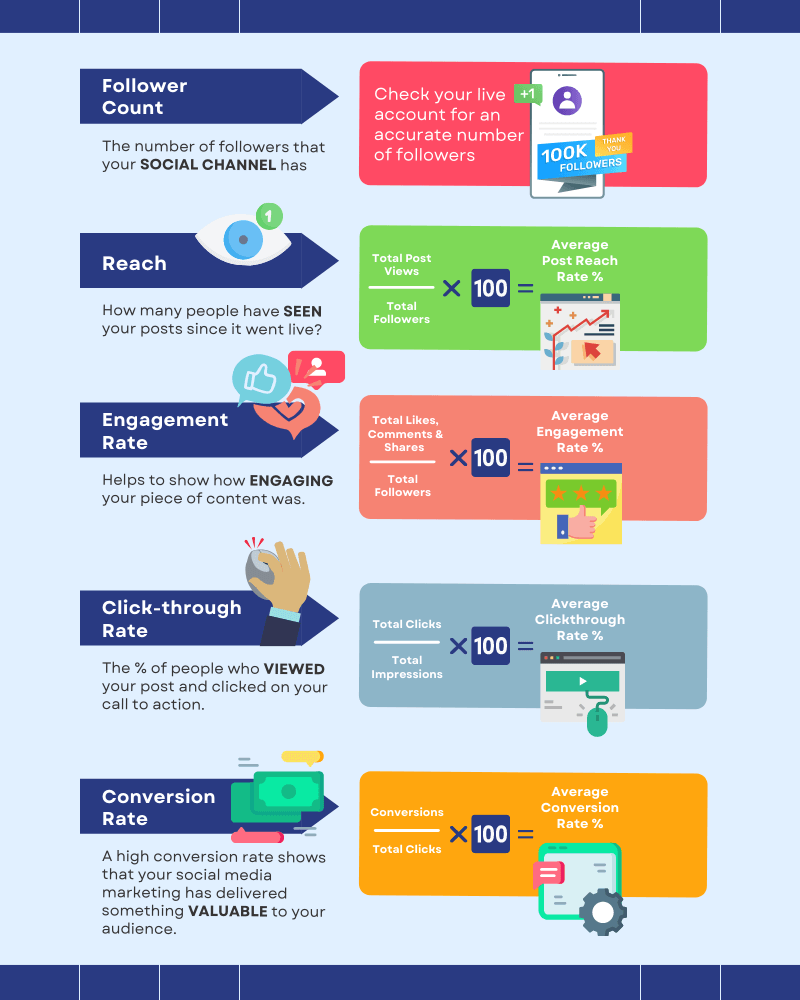KPI tracking refers to the methods and tools that can be used to monitor the performance metrics of a website. KPI stands for “key performance indicator.” Measuring KPI’s involves collecting specific data and converting it into useful metrics. These metrics can then be reported and measured in easily readable charts and dashboards.
Determining KPI’s is a vital step for both new companies and those that have been in the marketplace for a long time. To help ensure successful growth after KPI’s are established certain steps may be needed, including product content optimization, social media management, or content optimization services in Canada.
KPI’s show the situation of a company at that point in time. It can help outline any problems or roughness and helps to lay out the steps that can be taken to eliminate them. Areas and subjects in which the company is successful are highlighted, and the methods that work can then be repeated.
Set Goals
In order for KPI’s to work, businesses first need to set goals for themselves. These goals should be as realistic and selective as possible, and it should be clear in which area growth is most important in the digital market. For example, it could be the number of visitors to the site, the amount of interaction they give, or even the number of incoming emails. Setting these targets will depend entirely on the owners’ goals and the product or services they are selling.
KPI’s are specifically for the digital marketing field to determine the ratios of different digital metrics to each other. Some determined KPI’s however, should be specific to channels used.
For example, social media tools and the conditions under which visitors interact with these channels may be different compared to how visitors interact on a website. Google Analytics is a great web analysis tool that can help you to understand the behaviour of your users entering your website. It can allow you to create custom dashboards to separate all of your different goals.
Each social media channel has built-in analytics that can help you with your KPI’s. There are also a number of reliable social media metric trackers that can help monitor your numbers over a specific period of time.
Which Ones To Monitor?
One of the main problems with KPI’s is choosing from the thousands that are possible. If you choose the wrong one, you may be measuring something that doesn’t align with your goals. So how should you go about selecting the correct KPIs for your organization?
Your business may have many moving parts that are integral to its operations and performance, but it’s impossible to track everything going on. Many of these measures are simply not important enough to follow, and monitoring too many could create unnecessary work that ultimately will not be useful.
Instead, you will want to choose one or two metrics for each of your objectives that can be most helpful in achieving them. In many cases, multiple metrics could apply, but only a couple of them will be impactful enough to improve the performance of your business.
Indicators of Performance
Once you have chosen your metrics, you will want to ensure that they meet the criteria for a good KPI. Your KPI’s should be accurate indicators of performance and have some additional characteristics that could signal their effectiveness. Ask yourself these questions about each KPI you may be considering:
- Does this KPI connect to our objective?
- Is it simple to understand and define?
- Can it be easily quantified?
- Can it be measured in a timely manner?
- Will it still be relevant in the future
While KPI’s are an essential tool in measuring progress, they will only be helpful if done accurately and in a timely manner. Having an analyst responsible for collecting the data could be essential depending on the size of your business. An analyst should be able to analyze the results, put the data in context, and explain the performance. Our team at Unwired Web Solutions have the tools and experience needed to deliver the metrics that can help your business succeed.

Social Media KPI’s
What good is social media if you are not reaching your customers? But how do you know if your customers are responding to your posts, or if your posts are prompting a purchase? KPIs for social media can help you determine if your social media presence is doing its job.
There are specific KPI’s that should be measured across social media channels.
Impressions – this is the number of times that your post showed up in someone’s timeline or feed. However, this may not necessarily mean that the person who saw the post noticed it or even read it.
Follower count – this is the number of followers that your social channel has.
Audience growth rate – the growth rate demonstrates how your follower count is changing over time. You always want to make sure you are gaining followers, not losing them.
Reach – this measures how many people have seen your posts since it went live. This is a great metric to give you an idea of what your audience finds valuable and interesting. To calculate, divide your post views by total followers and times it by 100. This will give you your post reach percentage.
Likes– this is the number of times followers interacted with a social post by clicking the like button.
Comments – this tracks the number of times your followers commented on your posts.
Engagement rate – this metric helps to divide all the engagement a post receives, including likes, saves, comments, and favourites, by the total number of followers on your social channel. It helps to show how engaging your piece of content was. Add your likes, comments, and shares together and divide by your followers to find this metric. Then times by 100 to get your average engagement rate percentage.
Click-through rate – this is the percentage of people who viewed your post and clicked on your call to action. This metric can help provide insight into whether your content captures your audience’s attention and gets them to act. Get this calculation by dividing your total clicks by total impressions and times in by 100. This will give you your click-through rate percentage.
Conversion rate – conversion metrics show how effective your social media strategy is and whether it’s leading to sales, getting people to subscribe to a mailing list, visit a website or landing page, or other actionable outcomes. A high conversion rate shows that your social media marketing has delivered something valuable to your audience. To calculate it, divide your conversions by total clicks and times by 100. This will give you your conversion rate percentage.
Email Campaigns
If you run email campaigns as part of your marketing strategy, you will also want to track these. Many of the KPI’s for social media are the same for email campaigns. You will want to look at open rates, which are the metrics that will tell you how many people open your email. When looking at these metrics, it is important to note your email subject line to tell you if it is or is not an effective strategy. A catchy email subject line can make or break an email campaign.
You will also want to note your conversion rate and click-through rate the same as in social media. Bounce rate is also important to note for email campaigns as it will tell you how many people clicked on a link but then quickly left that page without taking any action. You want these numbers to be low as it signals that your content isn’t all that engaging or you have not provided an adequate user experience.
Don’t Put If Off
Many people put off measuring their KPI’s because they don’t know where to start or they think they may do it wrong. It’s not unusual for businesses to go off course as a result of using the wrong measures, but the sooner you uncover your mistakes, the better. At Unwired Web Solutions, our team of marketing experts can help to find the KPIs for your business and help with tracking. If your metrics show low numbers, you may need to rethink your marketing strategy, such as social media engagement changes or content rewrites. Contact us today for content optimization services in Canada or help with your social media marketing!


